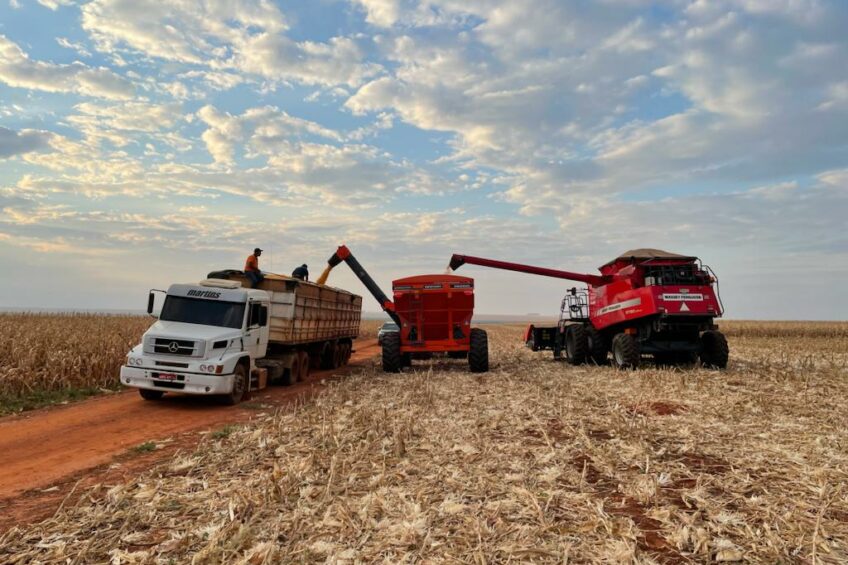High fertiliser prices: How are farmers worldwide coping with it? | Part III

Machinery, satellite imagery and biologicals were key to boosting profitability despite high production costs.
Some problems do not just have one solution. That is the case with the uprising of fertilizer prices, which affects producers profit and even their productivity. Due to this, the Brazilian farmer Nino Catelan Mosena decided to handle the issue by implementing a set of measures, always based on technology.
The young farmer is 33 years old and manages two properties of his family in the city of São Gabriel do Oeste, Mato Grosso do Sul state. He started just two years ago, after more than four decades of his father’s management.
Since the first moment, he was open to testing new tools in order to save fertilizers and keep (or even increase) productivity levels all over their 1,100 hectares dedicated mainly to soybean and maize. The area for sorghum, millet and grass is smaller.
He was ready to take the “bull by the horns” because, despite being from a “farmer family”, he also teaches agribusiness management in relevant institutions in Brazil.
However, the responsibility and the challenge of facing real life, beyond the books, was huge, and opportunities for improvement as well.
Variable rate saves 15 %
The first step he adopted was the variable rate for fertilizer application. It was even before the conflict between Russia and Ukraine that boosts NPK prices around the world.
According to Aprosoja (Brazilian Association of Soybean Producers), the increase reached up to 350% at some point in May, then started to fall. Despite that, these inputs never got back to previous parameters, and are still operating at new and higher price levels.
To do that, he brought a Jacto fertilizer spreader Uniport NPK 5030. “We had some plots with 800 kilos of NPK and others with less than 50 kilos. This was the first achievement and favoured greatly on our productivity”, he said.
Uniport 5030 NPK
Uniport 5030 NPK has a reservoir of 11.023 lb capacity and an application range of up to 164 ft for fertilizers, in addition to allowing applications of correctives. The equipment allows faster operations with a 35% smaller turning radius, providing greater operational efficiency and reducing crop dents in manoeuvres by up to 40%.
Additionally, there is control over the rotation of the dosing belt and the height of the floodgates, with automatic opening and closing, besides the care to preserve the granulometry of the fertilizers. The system can control the drop point of fertilizers on the discs and the exclusive shape of the blades, with 2 layers to provide the correct overlap for an excellent distribution.
The SmartSet is a tool built to assist farmers in adjusting the application range of your Uniport 5030 NPK. In four easy steps, they can get the necessary regulation data for a variety of fertilizers.
The machine uses digital controls to apply NPK precisely, which helped him to save 15% of the product. In addition, the new method increased, at the same time, until 10 more sacks of soybean in some areas, from 73 to 83 sacks of 60 kilos each.
The digital map was generated with the Otmis software, Jacto´s brand for technological solutions. The process uses guidance and application controls via GPS, automatic section controller and auto steer for variable rate
“If we remember fertilizers respond for around 20% of my production costs, we gain significant profitability only with that. The equipment also facilitated application due to 32 meters of working with and less soil compaction and trampling”, he added.
Yara app with satellite imagery
In the case of corn, Nino also adopted the Atfarm app from Yara this year, in order to improve nitrogen usage. The solution uses satellite images to create variable application maps in minutes, to apply nitrogen with precision and make better decisions.
“Creating these maps supported by agronomic Yara´s knowledge was an important asset for a new level of results. We have started to use Atfarm this year but I can already say imagery is a strong ally for producers like me”, he evaluates.
Concerning the results, Nino said they gathered 13 extra sacks of corn per hectare with Atfarm and special fertilizers, like the Absoluto composition. ”My father and I exchange ideas together and that is nice. I learn a lot from him and I think he learns from me as well, mainly on new technologies”, he said.
Text continues underneath image.

Nitrogen biological fixation
As an “early adopter”, Nino also wanted to test biologicals, such as inoculants, and NBF (Nitrogen Biological Fixation) to substitute increasing chemical fertilizers.
This technique is an enzymatic process, in which N2 is reduced to NH3 by the action of microorganisms. That is because, although the atmosphere is rich in nitrogen, it is not in the form that can be assimilated by plant organisms.
“I am a fan of inoculants and biologicals to replace chemicals. I have been looking for ways to introduce them for 2 years now. The first year was just to observe a small area and over time I’ve been doing more tests”, he explains.
The producer adds biologicals mainly as plant nutrition, but also to avoid soil compaction and even against plagues. According to him, some biological products have beneficial effects on soil microbiota, which is very effective against nematodes.
“I feel very comfortable testing and adopting new technologies. That is why companies invite me to test and validate some tools and solutions. And, certainly, I want to improve our results on productivity, profitability and sustainability”
Two properties, two realities
Nino´s family has two properties, one of them close to the city and the second about 25 kilometres out. That is enough to generate two different realities regarding digital solutions due to internet connectivity.
The first farm receives 4G signal and can benefit from digital farming and internet-focused farming. The second cannot. The farmer admits he likes to keep in contact with his suppliers like Yara, Jacto, Basf and Bayer.
“It is not just about the machine–computer data transference, but all aspects of the farm; management, communications and so on. Everything! The current level at this sector requires fast and smart decisions all the time”, he commented.
Also check out Part I en Part II in this series of articles!



